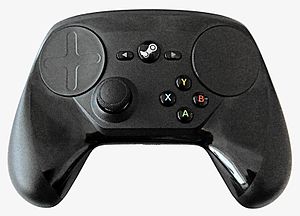Steam controller
 |
|
| Developer | Valve Corporation |
|---|---|
| Release date | November 10, 2015 |
| Website | store |
The Steam Controller is a game controller developed by Valve Corporation to be used with personal computers running Steam on Microsoft Windows, OS X, Linux or Steam OS. The controller is designed not only for games developed for controller users, but also for games traditionally played with keyboard and mouse controls so that they can be played through the controller.
The Steam Controller features two high-resolution clickable trackpads (replacing the typical thumbsticks on modern console controllers), and sixteen buttons, including face, shoulder, and undergrip buttons. The trackpads include haptic feedback, which can send tactile feedback to the player in reaction to events within the game; Chris Kohler of Wired described using the controller while playing Civilization V at a press event at Valve, and noted that as he used the trackpad to move the mouse cursor, electromagnets within the controller created audio and tactile feedback as if he were using a trackball. Although the controller is designed for the Steam Machine platform, it can also be used with Steam on existing PCs. The controller also included gyroscopic sensors to detect the relative orientation of the controller.
The controller is presently designed to be used within Steam's Big Picture mode; this enables the player to access detailed options for setting up the various features of the controller on a per-game basis including button/trackpad mapping and sensitivity, as well as accessing other users' shared controller configuration to use themselves. The Steamworks API provides means for developers to provide more detailed settings for the Steam Controller when in Big Picture mode. Outside of Big Picture mode, the controller otherwise behaves as a standard two-stick controller, though Valve does plan on updating Steam to allow retaining the previously set Big Picture mode per-game settings.
The original design of the controller was to include a touchscreen in the center of the unit. The touchscreen would have acted like a mousepad and allow players to perform actions that typically aren't capable on controllers, operating directly with Steam or SteamOS and overlays touchscreen display onto the players' screens to allow manipulation of the game without diverting attention from the screen. However, at the January 2014 Steam Dev Days event, Valve revealed they have since dropped the touchscreen concept from the controller, rearranged existing face buttons to be more compatible with existing games.
...
Wikipedia
